Map turtles are North American turtles belonging to the genus Graptemys. These turtles can be found throughout the United States. Map turtles are one of the most common turtles kept as pets.
This is because of their unique appearance. Map turtles are so-called because of the intricate couture-like patterns on their shells and skin. In addition to this, map turtles such as the northern map turtle and the texas map turtle are easy to find and adopt.
Table of Contents
- Experience Level: Beginner
- Family: Emydidae
- Scientific Name: Graptemys
- Average Male Adult Size: 4 to 5 inches
- Average Female Adult Size: 5 to 10 inches
- Lifespan: 15 to 100 years depending on species
- Clutch Size: 5 to 20 eggs
- Egg Incubation Period: 50 to 75 days
- Food: Aquatic turtle food, insects, fish, low-fat meat, and green leafy vegetable/edible aquatic plants
- Tank Size: 25 – 75 gallons (depending on size/gender)
- Average Temperature: 85°H/75°L
- UVB Lighting: Required
- Average Price Range: $5 to $50
- Conservation Status: From Least concern to Endangered, depending on the species
Map Turtle Species
1. Northern Map Turtle
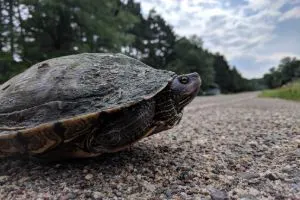
- Experience Level: Beginner
- Family: Emydidae
- Scientific Name: Graptemys geographica
- Common Names: Northern map turtle, common map turtle
- Average Female Adult Size: 7 to 10 inches
- Average Male Adult Size: 3.5 to 6.5 inches
- Lifespan: 15 to 20 years
- Average Price Range: $30 to $100
The northern map turtle is a popular aquatic turtle generally kept as a pet. This popular map turtle is also called the common map turtle.
The northern map turtle can be found throughout the eastern part of North America. They can be found in the St. Lawrence River drainage basin in southern Quebec, and Ontario in Canada.
In the United States, they are endemic to southern Wisconsin, Eastern Minnesota, Southern Kansas, Arkansas, Northeastern Oklahoma, Northwestern Georgia, Tennessee, and Alabama.
Like all map turtles, the common map has a sawlike keel that runs down its back. Their shells are olive to grayish brown with yellowish stripes.
2. Ouachita Map Turtle
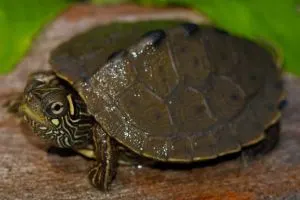
- Experience Level: Beginner
- Family: Emydidae
- Scientific Name: Graptemys ouachitensis
- Subspecies: G. o. ouachitensis & G. o. Sabinensis
- Average Adult Female Size: 5 to 10 inches
- Average Adult Male Size: 3½ to 5 inches
- Lifespan: 15 to 20 years
- Average Price Range: $20 to $50
Ouachita map turtles may not be as popular as the common map turtle or the false map turtle but they make great pets. These turtles are endemic to the United States.
The G. o. ouachitensis can be found in the Mississippi basin from Minnesota, Kansas, and West Virginia to Louisiana, while the G. o. Sabinensis are endemic to the sabine river system in Texas and Louisiana and the Mermentau and Calcasieu drainages of Louisiana.
The carapace of the Ouachita map turtle features yellow stripes with dark borders on an olive to grayish-black background.
3. Mississippi Map Turtle & False Map Turtle

- Experience Level: Beginner
- Family: Emydidae
- Scientific Name: Graptemys pseudogeographica
- Subspecies: False map turtle (G. p. pseudogeographica) & Mississippi map turtle (G. p. kohni)
- Average Female Adult Size: 6 to 10 inches
- Average Male Adult Size: 3.5 to 5 inches
- Lifespan: 30 to 50 years
- Average Price Range: $5 to $50
The species G. p. features two subspecies, namely the false map turtle (G. p. pseudogeographica) and the Mississippi map turtle (G. p. kohni). The Graptemys pseudogeographica looks very similar to other map turtles.
As such it is also known as a sawback turtle. Their carapace is olive to brown with marks that resemble contours on a map. The turtle has serrated posterior rims and sawlike keels.
The species Graptemys pseudogeographica is endemic to the Missouri and Mississippi River systems.
4. Texas Map Turtle

- Experience Level: Beginner
- Family: Emydidae
- Scientific Name: Graptemys versa
- Average Female Adult Size: 5 inches
- Average Male Adult Size: 3 inches
- Lifespan: 30 to 40 years
- Average Price Range: $30 to $100
The Texas map turtle is a popular map turtle species in the pet trade. This is because they are easily and readily captive bred. They are not a threatened species and are excellent turtles to adopt if you are looking to acquire an aquatic turtle.
Like other map turtles, the Texas map turtle has an intricate pattern of yellow stripes on their dark skin and carapace. The Texas map turtle is endemic to just Texas, particularly the Colorado River drainage.
5. Barbour’s Map Turtle
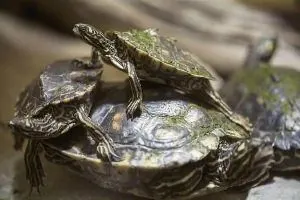
- Experience Level: Beginner
- Family: Emydidae
- Scientific Name: Graptemys barbouri
- Average Female Adult Size: 5 to 12.5 inches
- Average Male Adult Size: 3.5 to 5.5 inches
- Lifespan: 31 years
- Average Price Range: $30 to $100
The carnivorous Barbour’s map turtle is a captivating and interesting turtle. Just like other map turtles, the Barbour’s map turtle has contour-like lines on a greenish carapace.
The Barbour’s map turtle can be found in the Apalachicola River and its tributaries located in Southeastern Alabama, Southwestern Georgia and the Western panhandle of Florida
6. Black Knobbed Map Turtle
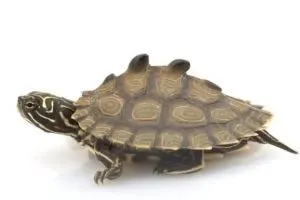
- Experience Level: Beginner
- Family: Emydidae
- Scientific Name: Graptemys nigrinoda
- Common Names: Black-knobbed sawback, black-knobbed map turtle
- Average Adult Female Size: 4 to 8 inches
- Average Adult Male Size: 3 to 4 inches
- Lifespan: 15 to 30 years
- Average Price Range: $100 to $200
The black-knobbed map turtle is another map turtle endemic to the fall lines of rivers in the Mobile Bay drainage, in Mississippi and Alabama. The most distinguishing feature of the black-knobbed map turtle is the knobs or protruding spikes on the carapace. These protrusions give the turtle its common name. As with other map turtles, female adults are much larger than males.
Another unique characteristic of the species that distinguish them from other map turtles is that they can only survive in freshwater systems.
Black-knobbed map turtles have been captive bred successfully and as such, if you want to adopt a specimen of the species, a captive-bred is the way to go.
7. Cagle’s Map Turtle
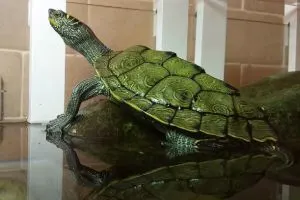
- Experience Level: Beginner
- Family: Emydidae
- Scientific Name: Graptemys caglei
- Average Female Adult Size: 5½ to 8 inches
- Average Male Adult Size: 3½ and 5 inches
- Average Price Range: n/a
Like most map turtles, the Cagle’s map turtle has serrated posterior rim and intricate patterns on an olive to dark-colored. The Cagle’s map turtle is native to the San Marcos river system in Texas as well as to Guadalupe in San Antonio.
The Cagle’s map turtle is an endangered species.
8. Alabama Map Turtle
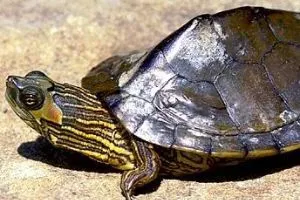
- Experience Level: Beginner
- Family: Emydidae
- Scientific Name: Graptemys pulchra
- Common Names: Northern map turtle
- Average Female Adult Size: 7 to 11 inches
- Average Male Adult Size: 3.5 to 5 inches
- Lifespan: 30 to 50 years
- Average Price Range: n/a
The Alabama map turtle was first discovered in Alabama but can be found in several states including Georgia, Florida, Mississippi, and Louisiana. They can be found in the Mobile Bay drainage basin, Pearl River, and Yellow River. The Alabama map turtle is dark in color and has yellow stripes on the shell and the skin. The stripe on the shell fades with time.
The Alabama map turtle is a near-threatened species on the IUCN. As such, if you wish to adopt one, do so from a reputable breeder.
9. Ringed Map Turtle

- Experience Level: Beginner
- Family: Emydidae
- Scientific Name: Graptemys oculifera
- Common Names: ringed map turtle or ringed sawback
- Average Female Adult Size: 8 inches
- Average Male Adult Size: 4 inches
- Lifespan: 23 to 37 years
- Average Price Range: n/a
The Ringed map turtle is a vulnerable map turtle species that is very close in appearance to black-knob map turtles and false map turtles. Its species can be found natively in the Pearl River system in Mississippi and Louisiana. The distinguishing feature of the Ringed map turtle is the light-colored rings on the carapace.
Ringed map turtles are hardly kept as pets.
10. Escambia Map Turtle
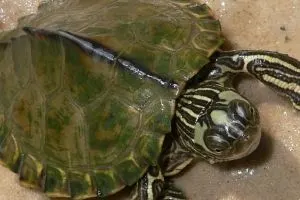
- Experience Level: Beginner
- Family: Emydidae
- Average Female Adult Size: 11 inches
- Average Male Adult Size: 5 inches
- Scientific Name: Graptemys ernsti
- Average Price Range: n/a
The species Graptemys ernsti is endemic to the Escambia Bay drainage, hence their common name. The species are near-threatened and their wild populations are falling. The Escambia map turtle is hardly kept as a pet.
11. Yellow-Blotched Map Turtle

- Experience Level: Beginner
- Family: Emydidae
- Scientific Name: Graptemys flavimaculata
- Average Female Adult Size: 5 to 7 inches
- Average Male Adult Size: 3.5 to 4.5 inches
- Average Price Range: n/a
The Yellow-blotched map turtle is a threatened species whose wild population is on the decline. The Yellow-blotched map turtle has the highest central keel of all the map turtles.
It also has yellow blotches on the shell. The Yellow-blotched map turtle’s wild populations are limited to just the Pascagoula River system in southern Mississippi.
12. Pascagoula Map Turtle

- Experience Level: Beginner
- Family: Emydidae
- Scientific Name: Graptemys gibbonsi
- Average Female Adult Size: 11 inches
- Average Male Adult Size: 5 inches
- Average Price Range: n/a
The Pascagoula map turtle and Yellow-blotched map turtle are both limited to just the Pascagoula River system in southern Mississippi. The species is endangered and their population is falling rapidly.
13. Pearl River Map Turtle
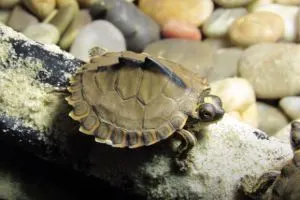
- Experience Level: Beginner
- Family: Emydidae
- Scientific Name: Graptemys pearlensis
- Common Names: Northern map turtle
- Average Female Adult Size: 7 to 10 inches
- Average Male Adult Size: 3.5 to 6.5 inches
- Average Price Range: n/a
The Pascagoula map turtle and the Pearl River map turtle used to be considered as the same species but in 2010, the Pearl River map turtle was recognized as a separate species.
Like the ringed map turtle, the Pearl River map turtle is also endemic to just the pearl river. This is also where they acquired their common name.
14. Sabine Map Turtle

- Experience Level: Beginner
- Family: Emydidae
- Scientific Name: Graptemys sabinensis
- Common Names: Sabine map turtle
- Average Female Adult Size: 5 to 11 inches
- Average Male Adult Size: 3.5 to 6 inches
- Average Price Range: n/a
The Sabine map turtle looks very much like any other map turtle. They look very much like the Ouachita map turtle and were once considered a subspecies of the Ouachita map turtle.
They have intricate yellow patterns on their olive to brown carapace as well as on their skin. The Sabine map turtle unsurprisingly is endemic to the Sabine River system of Louisiana and Texas. The Sabine map turtle is not generally kept as pets.
Map Turtle Care
Map turtles are aquatic species and can be found in river systems, drowned forests, ponds, lakes, and many more. They prefer freshwater ecosystems with slow-moving currents and basking spots.
Enclosure

The map turtle requires an aquatic setup such as a pond or an aquarium. While young map turtles can thrive in small tanks, adults need to be moved to large aquariums.
An aquarium with a capacity of 50 gallons should be adequate for a single adult map turtle. SeaClear makes a nice 50 gallon acrylic tank which is lighter and more durable than the traditional glass tanks. For very large adults, you may need to acquire a much larger aquarium. You can look at SC Aquariums (up to 150 gallon) for that.
The enclosure needs a basking platform that is accessible. A basking platform such as the Penn Plax Turtle Tank Topper is a good choice, though depending on size you might need to make a basking platform, or look for other alternatives.
The enclosure also needs a powerful filter such as the SunSun HW-302. There are higher capacity versions available as well if you need it.
Substrate
For beginners, I do not recommend substrates as they make the maintenance more difficult. For example, substrates can trap food particles and make for a less hygienic environment.
If you must have substrate I recommend river rocks. Not only do these feel natural to the turtle’s habitat but they are also large enough so the turtle cannot accidentally swallow them.
Temperature
The right temperature ensures that the environment is comfortable and promotes good health. The water temperature needs to be in the mid 70 degrees Fahrenheit (no lower than 70).
The basking area needs a temperature of high 80s to low 90s. The ambient temperature needs to be in the low to mid-80s.
Maintain the right temperatures using a heat lamp such as a ceramic heat lamp and a submersible heater. Check the temperature with a thermometer before installing a submersible heater.
I recommend the Infrared Ceramic Heat Lamp or the Zoo Med Aquatic Turtle UVB & Heat Lighting Kit. Many other options exist.
Regulate the heating units with thermostats.
Lighting
Map turtles need UVB light to grow and maintain the right body structure. If the turtle lives in an outdoor pond, then the sun is the best source of UVB.
Never place a glass aquarium in the sun. the glass heats up quickly. Light up aquariums using UVB bulbs like the Zoo Med ReptiSun.
Feeding the Map Turtle
Map turtles may be omnivores, but in the wild, they feed on insects, snails, clams, crayfish, and other smaller crustaceans. They also feed on carrion and some plant material.
Feed pet map turtles commercial aquatic turtle diets such as Mazuri aquatic turtle diet and Zoo Med Gourmet Reptisticks Floating Aquatic Turtle Food. In addition to this, map turtles also accept insects (mealworms, crickets, bloodworms, and earthworms), shrimps, feeder fish, and krill.
Plants to offer them include hornwort, pondweed, water lilies, frogbit, duckweed, and water hyacinth.
Alternatively, you can try zucchini, mustard greens, kale, escarole, red leaf lettuce, romaine lettuce, dandelions, and squash.
Feed juveniles daily and adults once every two days. Feed them as much as they can eat during the feeding period.
Map Turtle Temperament & Handling
Map turtles are display pets and should not be handled unless it’s absolutely necessary. Map turtles can live with other terrapins/North American freshwater turtles in the same aquatic enclosure.
Map Turtle Lifespan
The average life expectancy of these turtles is 15 to 100 years depending on the species. Expect most species such as the Mississippi, Northern, and Ouachita map turtles to live to about 30 years.
Map Turtle Health Concerns
Map turtles like other turtles are hardy species. As such, they hardly suffer from health complications. Here are some of the more common health issues.
Vitamin A deficiency – this is usually down to poor diet choices. Feed the turtle a well-rounded diet of commercial turtle food, fresh vegetables, insects, and seafood.
Also, supplement their diets with vitamins and minerals like this one from Flukers which includes vitamin D3. Some symptoms include raw skin, lethargy, lack of appetite, swollen eyes. If the case is severe, you must visit a herp vet.
Metabolic bone disease and shell pyramiding – These diseases deform the turtle’s skeletal structures. MBD is down to a deficiency in calcium and vitamin D3.
It leads to deformed bones and shells. Pyramiding is down to overfeeding the turtle protein. Keepers generally do this so the turtle grows bigger quickly.
A pyramided shell is not a nice sight. A dietary change can solve these issues when noticed early.
Cuts and bruises – Your turtle can injure himself in the course of his life. Treat injuries with a betadine solution. When you notice an injury pinpoint the cause and neutralize it. It can be an accessory with a sharp edge. If the injury is caused by another aquatic housemate, quarantine the aggressor.
Map Turtle Pricing and Availability
The most popular map turtles normally adopted as pets include the Mississippi, northern, and Ouachita map turtles. Because of the four-inch law, the trade of map turtles has dropped significantly.
However, map turtles are still among the most popular aquatic turtles kept as pets. Other map turtle species available on the market include the black-knobbed map turtle, Cagle’s map turtle, Texas map turtle.
Don’t expect to pay more than $50 for the popular map turtle species. Some sources of reputable breeders include Underground Reptiles, the turtle source, and BackwaterReptiles.com.
Conservation/Threats
Different map turtles have different conservation status. While more popular species such as the Northern map turtle, Mississippi map turtle, and the Ouachita map turtle have conservation statuses of least concern.
Other species such as the Pascagoula map turtle and the Pearl River map turtle are endangered species.
Threats to these species include modification & destruction of the natural habitat and other human intrusions and disturbances.
Common Questions
How big will a map turtle get?
The size of map turtles can vary greatly depending on the species. Generally, they can range from 3 to 12 inches in shell length when fully mature, with females typically being larger than males.
Can map turtles be pets?
Yes, map turtles can be kept as pets, but they require specific care including a suitable aquatic environment, a balanced diet, and UVB lighting. They are best suited for intermediate to advanced turtle keepers due to their specific needs.
What is the lifespan of a map turtle?
Map turtles can live a long time with proper care. Their lifespan in captivity typically ranges between 15 and 30 years, and some may even live longer.
Can map turtles survive winter?
In the wild, map turtles survive winter through a process called brumation, similar to hibernation, where their metabolism slows down significantly. In captivity, however, map turtles should be kept in a controlled environment where they can maintain their regular activities year-round.
Conclusion
Map turtles are among the most popular turtles kept as pets and that’s for good reason. These turtles are not only hardy, but they are also interesting.
Although map turtles are strictly display pets, they offer so much more. They are interesting to watch and feed. While acquiring a map turtle, it’s best to go for a popular species such as the Mississippi map turtles.
These are readily bred. Also, it is best to avoid handling map turtles as this stresses them. Also, map turtles may carry salmonella.
Remember to wash your hand before and after handling one.
If you have any information or questions leave a comment.

Laurie
Sunday 15th of May 2022
Hi, I have a Mississippi map turtle, about 15 years old. I took him to a herp vet for the first time ever last week because of a concerning bulge at his shell opening, left rear leg. She was not sure what the cause was, but gave 3 possibilities: he ate some gravel (that has since been removed and there is no longer any substrate in his tank), it’s an infection (she gave me an antibiotic for that, which he has taken 4 times so far - there does seem to be a reduction in the swelling), or he is actually a she, and has eggs to lay. Everything I’ve looked at, though, says he’s male. Do you know of anything else it could be? Also, if he ate gravel, will he be able to pass it?
Thanks